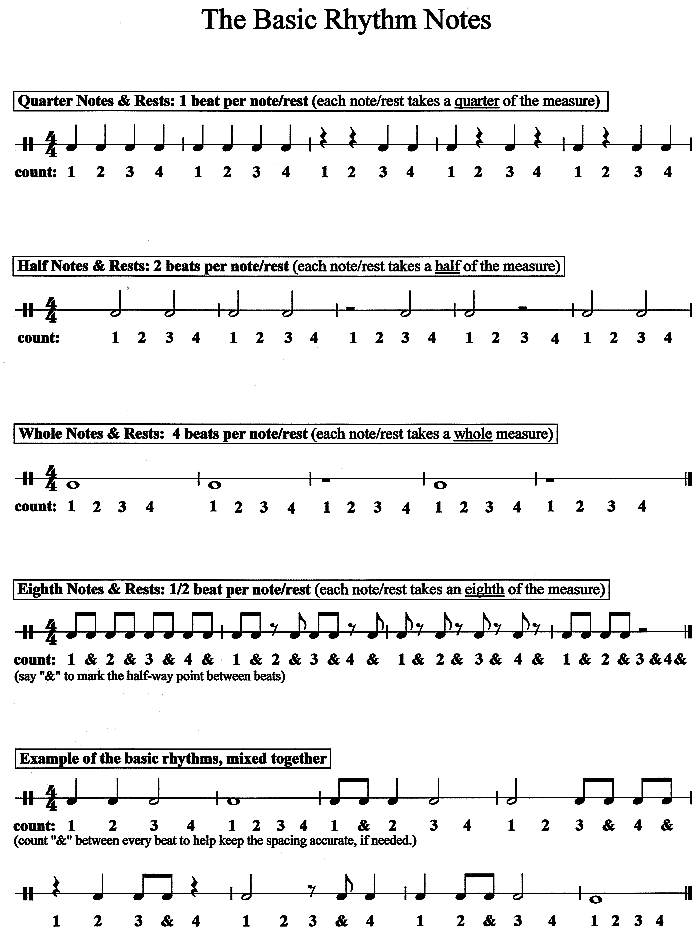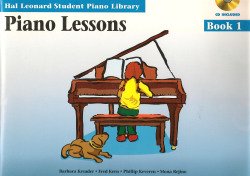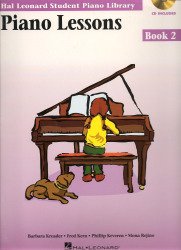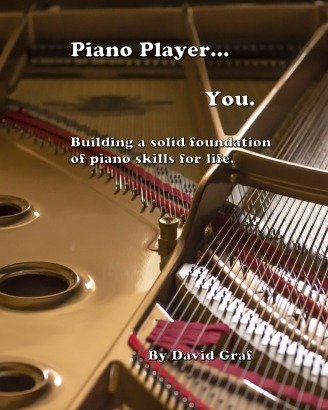The purpose of this website: helping you learn to play the piano. Building a strong foundation of piano-playing skills will lead to a lifetime of piano-playing joy.
Reading Music: start with knowledge and then practice, practice, practice!!
Reading music is not rocket science. A simple outline of your path to success:
1. Learn the notes (bass clef & treble clef) as they are written and how they correspond to the keys on the piano. (Go to "Piano Notes" .) Note flashcards are handy for drilling the notes. (see: "Read Piano Notes")
2. Learn how to count the rhythms. (see "The Basic Rhythm Notes" below)
3. Combine the notes and the rhythms, taking advantage of expertly written piano method books which are the most thoughtful and trustworthy resources for developing pianists.
(I highly recommend the Hal Leonard Student Piano Library, which can be found at most music stores, or online at sheetmusicplus.com -new window will open-. Use the "Piano Lessons" and the "Piano Solos" with CDs, and you cannot go wrong. For absolute beginners, start with "Book 1".)
For direct links to these method books, as well as more thorough descriptions, see "Piano Music Books" .
A plan for developing your music reading skills using these method books is detailed below under the headline "How To Practice Your Piano Music Reading Skills".
Once you understand the basic elements, practice patiently, persistently, and consistently and success will follow.
Reading music at the piano will enhance your piano skills, as well as your overall musicianship. So let’s get to it! (Chapter 6 of "Piano Player... You" provides in depth material on this subject)
[Before diving into music reading, get to know your keyboard by working through "Free Piano Lessons" . You should master at least 7 or 8 (or all) of the lessons offered, and then return here to begin learning how to read.]
For a more complete understanding of how to build your piano-playing foundation, read
For the most direct, organized, and progressive path to learning to play the piano, start
the Piano Skills Foundation series of piano lessons.
(Advertisement)
Reading Music:
Learning How To Read And Count Rhythms
The following exercises provide examples of the 4 most basic rhythm notes (quarter notes, half notes, whole notes, and eighth notes). Try clapping these rhythms while counting out loud and keeping a steady beat (a metronome set at a slow tempo helps).

Piano music combines rhythm notes like these with the notes on the grand staff. Once you are reading and playing at the piano, your rhythm skills will only develop if you are willing to count out loud for several levels.
How To Practice Your Piano Music Reading Skills
If you are a stark beginner and have no experience reading music, start at the beginning of the Hal Leonard Student Piano Library. Book 1 begins with "pre-reading", meaning it is for people with no music reading experience at all.

Quick links:
Hal Leonard Student Piano Library, Lessons Book 1
and
Solos Book 1
. (New window will open.)
If you have had some experience reading music at the piano, but still
consider yourself a beginner, you might consider starting with Book 2.

Quick links:
HLSPL Lessons Book 2
and
Solos Book 2
. (New window will open.)
Each level of this method book series (5 levels) has a "Lessons" book, a
"Solos" book, a "Theory" book, a "Technique" book, etc... For just the
reading music essentials, all you need are the "Lessons" and "Solos"
books at each level. (The others are also helpful, but not as
necessary).
Quick links to the rest of the HLSPL series:
Lessons Book 3
Solos Book 3
Lessons Book 4
Solos Book 4
Lessons Book 5
Solos Book 5
Once you have figured out where to start, begin learning each piece using the following routine:
1. Play each phrase (usually 4 measures, and often laid out 1 phrase per line) until you have done it at least 3 times perfectly. Always overlap to the first beat of the next phrase. (This helps you link the phrases together.)
-If both hands are playing together (i.e.: there are notes in both treble and bass clefs at the same time), you must practice each hand separately, before playing 3x perfectly with both hands.
-Use your metronome to help you keep a steady beat. Start at a tempo slow enough to allow the 3x perfect to be achieved within 5 to 10 attempts.
2. Once you've played each of 2 consecutive phrases 3x perfectly, play through both a few times (3x perfectly if you want). Then, work on the next phrase and continue the process until you have learned the whole piece and can play it through at a steady (and slow, at this point) tempo.
3. Use your metronome to help gradually increase the tempo up to the tempo indicated on the music. (In the Hal Leonard series, performance tempos are always noted.) Once you can play the piece at the top tempo, you can play it with the CD.
-In the Hal Leonard series, each piece is played on the CD two times. The first performance is slower (a "rehearsal tempo"), and has piano playing along. The second performance is the faster "performance tempo" and has no piano part playing along. It's just you and the orchestra. This is not just a good music playing and listening experience, it's also fun!!
-Once you can play the piece with the CD (and have done it many times), then you are ready to move on to the next piece. Make sure you do not move on until you play each piece easily and well.
Two Rules For Music Reading:
When working on your music reading skills:
1. Always KEEP YOUR EYES ON THE MUSIC!!! (No looking at your hands)
2. Always COUNT OUT LOUD!!! (No counting "in your head")
Follow
these rules and you will be reading music successfully after a few
years of practice. Do not follow these rules and you will never be a
very good music reader.

If you want to see a blueprint for a successful piano journey...
read
"Piano Player... You"
A guide to building a solid and complete piano-playing foundation.
-Click here to learn more about this e-book-
If you would like a step-by-step guide to help you on your piano journey...
start working through
"The Piano Skills Foundation" piano lessons
-Click here to learn more about this piano course-
Return from "Reading Music" to "Home".
Looking for some piano music?
I have found Sheet Music Plus to be a fantastic resource for piano books & other materials. And they have instant digital downloads for thousands of individual pieces.
3 Ways To Support This Website
If you enjoy using true-piano-lessons.com and would like to help support it:
1. Buy the ebook, "Piano Player... You"
2. Purchase "Piano Skills Foundation"
3.Donation
